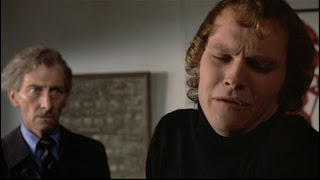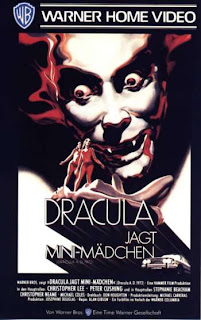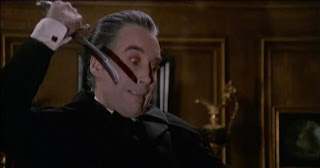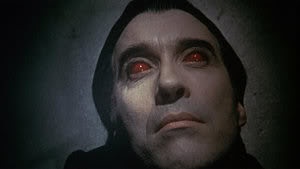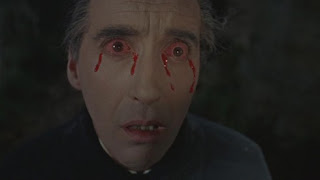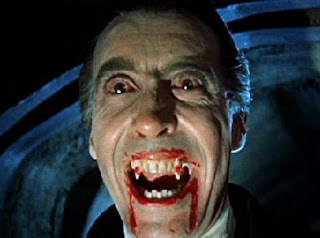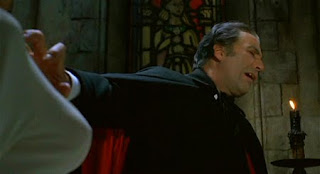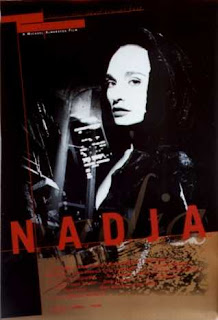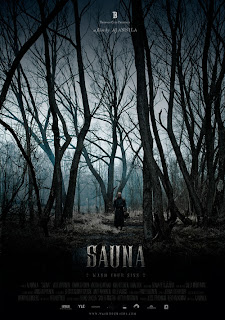(Too bad I decided on a "no nudity" policy for this blog - I could have put a really good picture here otherwise.)
While this happens, a man who is tied up in another room manages to escape. He runs a gauntlet of guys in sheepskin coats on motorbikes, who are gunned down by someone in a black car. The man manages to drag himself into the car and is driven back to a secret headquarters, where British government agents quiz him about what he's witnessed. He describes the ceremony in detail (even though he didn't seem to be in the room at the time) including how the woman was stabbed, seemed to die, then revived and her wound healed in seconds. He also has five photos taken with his secret-agent-wristwatch, which show that the leaders of the cult are a top scientist, a peer of the House of Lords, a general, and the government official who actually heads the department the secret agents are working for. The fifth photo shows an empty doorway - do you think it could actually be someone who doesn't show up on film?

Unsurprisingly, they are not pleased about this. They would be even less pleased if they knew that their secretary was being chased down and kidnapped by the guys on motorbikes.
They decide that the only course of action is to call in the same bumbling Scotland Yard inspector from the previous movie, who in turn calls in Lorimer Van Helsing. It turns out that the scientist is an old friend of Van Helsing, so he goes to see him and discovers that he has created a massively beefed-up version of the bubonic plague that will destroy all human life extremely quickly if released. The next thing you know he has been knocked unconscious by a bullet to the head (huh?) and wakes to find that his friend is hanging from a noose and the Petri dishes containing the plague have gone.
The inspector and two of the agents then proceed to head to the mansion where the rituals had taken place and knock on the door, seemingly without any sort of plan or even a coherent cover story, and set about making light banter with the woman who lets them in (who just happens to be the same person who lead the rituals at the start of the movie).
Meanwhile Van Helsing's daughter Jessica (this time played by Joanna Lumley) also sneaks into the building and heads straight to the basement, where she is promptly attacked by four female vampires, one of whom is the kidnapped secretary. Her screams draw the authorities, who rush down to stake their former secretary and rescue Jessica.

It turns out that the cult is lead by someone called D. D. Denham, a mysterious recluse who has never been seen and who just happened to turn up at around the time that Dracula had been staked two years earlier and whose headquarters are on the site of the demolished church. The minute that Van Helsing discovers this, he heads straight to the lion's den and demands to be shown in. For some reason Dracula attempts to disguise his identity by shining a light into Van Helsing's eyes and putting on a funny accent, and he attempts to sway the vampire hunter to his side by explaining that he wants to use the plague to overthrow the governments of the world and set up a new order.
For some reason, Van Helsing doesn't seem to think that this is a very good idea. He promptly tries to shoot the Count with a silver bullet, but is stopped by the intervention of some of the other cult leaders. Dracula has him taken to the mansion, where Jessica has been kidnapped and laid out for sacrifice.

It turns out that the whole plot is basically a huge suicide mission for Dracula: he plans to wipe out the entire human race so that, deprived of a food source, he will finally have his eternal rest. In the meantime he wants Jessica as his consort just to fuck with Van Helsing's head. The rest of the cult are disturbed to hear that they are to be infected with the plague and used to spread it, as they thought they were just going to use it as blackmail to obtain massive power, but Dracula controls their minds and starts forcing them to infect themselves.
Fortunately (or unfortunately, depending on your viewpoint) the bumbling cop has managed to start a fire upstairs, which now spreads to this room. Van Helsing leaps out of a window, pursued by Dracula, and manages to lure him into a Hawthorn bush (supposedly what Christ's crown of thorns was made from), which messes him up enough that Van Helsing can stake him.

In my review of Dracula AD 1972, I expressed dismay that no effort was made to bring the Count effectively into the modern world, and also observed that the music made the movie seem like an episode of an ITV series. I guess I should be careful what I wish for. While this movie is energetic and fun, it's just about as far from what I want from a Dracula movie as I could imagine, with the Count reduced to the role of a corporate villain in a cheap spy movie.
The heroes are all bumbling idiots - even Van Helsing stupidly walks into a trap for no good reason - and are only saved by sheer dumb luck or (in one mind-boggling instance) because vampires can now apparently be killed by clear running water. Which means that turning on the sprinkler system does in a whole roomful of them. Joanna Lumley, who would go on to kick arse in The New Avengers two years later, spends way too much time here standing around and screaming hysterically.
On the plus side, at least Christopher Lee didn't go out of the series at its lowest point (that was Scars of Dracula, unless the next movie proves to be even worse), and it's still fun to see him and Cushing together. They would continue to be teamed up in movies until House of Long Shadows in 1983.

There's only one more stop in my Hammer Dracula marathon. Having failed to update the Count to swinging London or to a modern spy epic, it was decided that the obvious thing to do was to take him back to period (1904 to be precise), to pit him once more against the original Van Helsing (who Dracula: AD 1972 had showed as dying 32 years earlier), and - crucially - to put him in a kung-fu movie. Tune in tomorrow for the only collaboration between Hammer and the Shaw Brothers: Legend of the Seven Golden Vampires!





